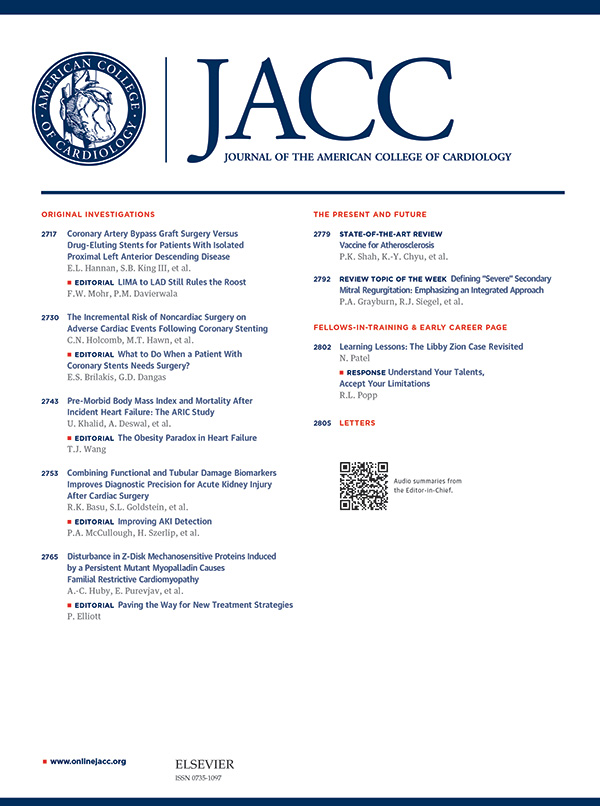糖尿病患者的强化生活方式干预、心脏生物标志物和心血管预后:LookAHEAD 心脏生物标志物辅助研究
IF 21.7
1区 医学
Q1 CARDIAC & CARDIOVASCULAR SYSTEMS
引用次数: 0
摘要
背景NT-proBNP和hs-cTnT与心血管预后有关,建议对2型糖尿病(T2D)患者进行测量。然而,以减轻体重为目标的强化生活方式干预(ILI)对心脏生物标志物的影响,以及这些生物标志物的变化与 T2D 患者不良心血管结局风险的预后关联尚未得到充分证实。方法 LookAHEAD 试验的参与者在基线(3984 人)、1 年和 4 年时接受 NT-proBNP 和 hs-cTnT 测量。ILI(与糖尿病支持和教育[DSE])对心脏生物标志物的影响采用调整线性混合效应模型进行评估,并以几何平均比(GMR)进行总结。结果平均基线 NT-proBNP 和 hs-cTnT 分别为 77 和 10.7 ng/L。ILI(vs.DSE)导致1年内NT-proBNP增加(GMR[95% CI]:1.14[1.08-1.20]),但这一差异在4年内有所减弱(GMR[95% CI]:1.01[0.96-1.07])。ILI(与 DSE 相比)可降低 1 年(GMR[95% CI]:0.94[0.91-0.97])和 4 年(GMR[95% CI]:0.93 [0.90-0.96])的 hs-cTnT。体重在 1 年内明显减轻(≥5% vs. <5%)的参与者,其 NT-proBNP 在短期(1 年)内显著增加,但在长期随访(4 年)中减弱。1 年的体重减轻与长期的 hs-cTnT 下降显著相关。在调整后的 Cox 模型中,NT-proBNP 的增加与 ASCVD 综合结果和 HF 风险的增加显著相关,与心脏生物标志物的基线测量值和风险因素的变化无关。结论在患有 T2D 的成年人中,ILI 导致随访期间 hs-cTnT 显著降低,但 1 年后 NT-proBNP 水平会短暂升高,且随着时间的推移会逐渐降低。NT-proBNP和hs-cTnT的纵向评估提供了ASCVD风险的预后信息,而只有NT-proBNP的变化能预测HF风险。本文章由计算机程序翻译,如有差异,请以英文原文为准。
Intensive lifestyle intervention, cardiac biomarkers, and cardiovascular outcomes in diabetes: LookAHEAD cardiac biomarker ancillary study
Background
NT-proBNP and hs-cTnT are associated with cardiovascular outcomes and are recommended for measurement in type 2 diabetes (T2D). However, the effects of an intensive lifestyle intervention (ILI) targeting weight loss on cardiac biomarkers and the prognostic association of changes in these biomarkers with risk of adverse cardiovascular outcomes in T2D are not well-established.Objectives
To evaluate the effects of an ILI on cardiac biomarkers and the association of changes in cardiac biomarkers with risk of cardiovascular outcomes in T2D.Methods
Participants of the LookAHEAD trial underwent NT-proBNP and hs-cTnT measurement at baseline (N=3,984), 1- and 4-years. The effects of the ILI (vs. diabetes support and education [DSE]) on cardiac biomarkers were assessed using adjusted linear mixed-effect models and summarized as geometric mean ratios (GMR). Associations of longitudinal changes in cardiac biomarkers with risk of cardiovascular outcomes were assessed using adjusted Cox models.Results
Average baseline NT-proBNP and hs-cTnT was 77 and 10.7 ng/L, respectively. The ILI (vs. DSE) led to an increase in NT-proBNP at 1-year (GMR[95% CI]: 1.14[1.08-1.20]), but this difference was attenuated by 4-years (GMR[95% CI]: 1.01[0.96-1.07]). The ILI (vs. DSE) led to lower hs-cTnT at 1-year (GMR[95% CI]: 0.94[0.91-0.97]) and 4-years (GMR[95% CI]: 0.93 [0.90-0.96]). Participants with meaningful weight loss by 1-year (≥5% vs. <5%) had a significant increase in NT-proBNP in the short-term (year-1) which attenuated in the long-term follow-up (year-4). Meaningful 1-year weight loss was significantly associated with reduction in hs-cTnT in the long-term. In adjusted Cox-models, increase in NT-proBNP was significantly associated with higher risk of the composite ASCVD outcome and HF independent of baseline measure of the cardiac biomarker and changes in risk factors. In contrast, longitudinal increase in hs-cTnT was significantly associated with higher risk of the composite ASCVD outcome but not HF in the most adjusted model.Conclusions
Among adults with T2D, an ILI led to a significant reduction in hs-cTnT on follow-up but a transient increase in NT-proBNP levels at 1-year that attenuated over time. Longitudinal assessment of NT-proBNP and hs-cTnT provide prognostic information for ASCVD risk while only changes in NT-proBNP predicted HF risk.求助全文
通过发布文献求助,成功后即可免费获取论文全文。
去求助
来源期刊
CiteScore
42.70
自引率
3.30%
发文量
5097
审稿时长
2-4 weeks
期刊介绍:
The Journal of the American College of Cardiology (JACC) publishes peer-reviewed articles highlighting all aspects of cardiovascular disease, including original clinical studies, experimental investigations with clear clinical relevance, state-of-the-art papers and viewpoints.
Content Profile:
-Original Investigations
-JACC State-of-the-Art Reviews
-JACC Review Topics of the Week
-Guidelines & Clinical Documents
-JACC Guideline Comparisons
-JACC Scientific Expert Panels
-Cardiovascular Medicine & Society
-Editorial Comments (accompanying every Original Investigation)
-Research Letters
-Fellows-in-Training/Early Career Professional Pages
-Editor’s Pages from the Editor-in-Chief or other invited thought leaders

 求助内容:
求助内容: 应助结果提醒方式:
应助结果提醒方式:


